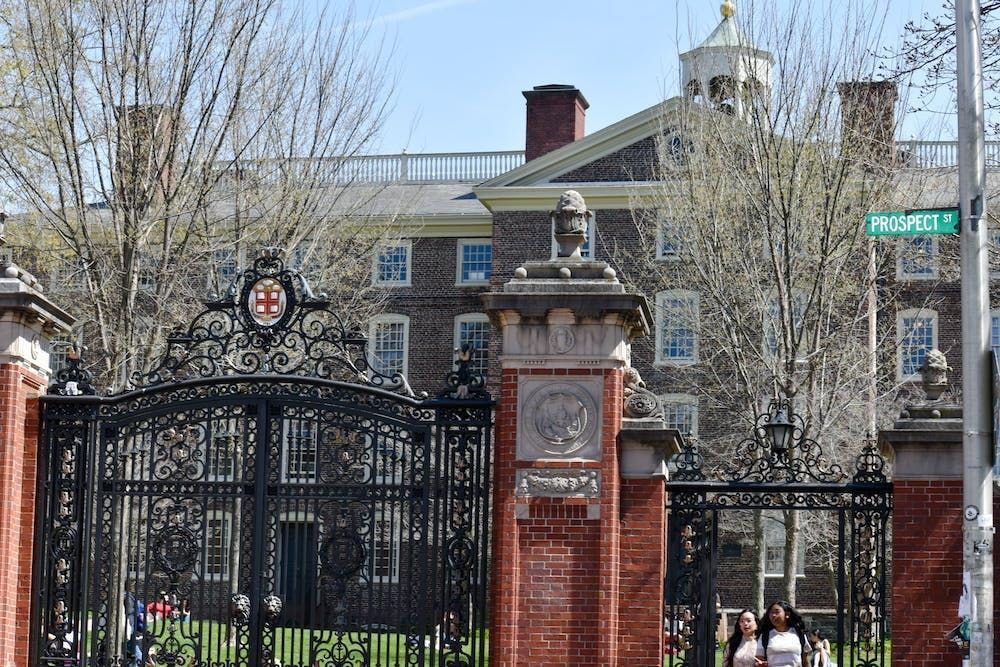Brown and other Ivy League schools have recently faced intensifying scrutiny about the economic diversity of their student bodies.
One analysis from the New York Times showed that the University was tied for 230th of 286 schools in its percentage of Pell Grant recipients — the lowest among all Ivy League schools.
Financial aid offers a high-level, if imperfect, view of a college’s economic diversity. Packages vary from student to student, but the portion of students who apply for and receive financial aid, as well as the average package, create data points detailing a given school’s financial accessibility.
By dollar value, Brown’s financial aid packages are squarely in the middle of the pack among its Ivy League peers. But the University consistently ranks lowest or second-lowest in the Ivy League in the portion of students who apply for and receive financial aid, The Herald’s analysis of Common Data Sets from 2012-13 to 2022-23 found.
The numbers
From 2012-13 to 2021-22, Brown ranked last in the Ivy League in the percentage of students receiving financial aid. The gap between Brown and Penn, its closest peer, has been as big as 5% and as small as fractions of a percentage point through the years. In the 2022-23 academic year, Penn’s proportion of students receiving aid dipped slightly lower than Brown’s.
The proportion of students who receive financial aid at the University has also remained relatively stable over the past 10 years, hovering around 45%.
Brown also has one of the lowest proportions of financial aid applications from its students, trading off with Penn in recent years.
But for financial aid application rates for first-years, Brown is among the middle of the Ivies: The number has fluctuated between just under 50% and over 63%.
For non-first-years, the percentage applying for aid drops to the lowest in the Ivy League — between 44 and 49%. The drop has occurred in each year over the past decade, though similar drops are visible at most other Ivy schools each year.
In an email responding to these trends, University Spokesperson Brian Clark pointed to an increase in students hailing from “moderate-income households” after the implementation of the Brown Promise in 2018.
The Brown Promise is an initiative that replaced loans with scholarship funds in the University’s undergraduate financial aid packages, The Herald previously reported.
“In 2017-18, 54% of incoming first-year undergraduates came from moderate-income households,” he wrote. “By 2022-23, it had surged to 67%.”
The University defines moderate-income households as “families with incomes in excess of $100,000 yet a combination of income and assets in which they still receive need-based scholarships,” according to Clark. They are usually “students who typically do not qualify for the level of financial aid offered to families with lower incomes, yet also do not have the full resources to cover the cost of attending college.”
Another way to look at Brown’s financial aid is through the award rate, the proportion of students applying for aid who ultimately receive assistance. The number has fluctuated since 2012-13, when it stood at a high mark of 92%. It dropped to 83.64% in 2018-19, but has fluctuated between 85 and 87% since 2020-21.
Brown ranks solidly in the middle of the Ivy League in average financial aid and need-based grants awarded, with a steady increase in the average award amount over the past decade as the cost of attendance has also risen.
How does Brown determine financial aid?
Brown meets 100% of students’ demonstrated financial need, allowing the University to enroll “exceptionally talented students from all socioeconomic backgrounds,” Clark wrote.
He also noted “financial aid offers, the share of undergraduates receiving financial aid, the distribution of students across income levels and many other indicators” in “recent decades” as evidence of strengthened socioeconomic diversity on campus.
From 2012-13 to 2022-23, the share of undergraduates receiving financial aid has not changed significantly, though the size of the student body has grown, meaning the total number of students who receive financial aid has grown.
There has also been a decrease in the percentage of students receiving Pell Grants — a federal scholarship reserved for students with “exceptional financial need” — on campus. The University did not provide data detailing the distribution of family income levels on campus.
Colleges employ a federal methodology to determine federal student aid awards, according to Jill Desjean, senior policy analyst at the National Association of Student Financial Aid Administrators.
In addition to federal policies, the University uses an institutional methodology policy to award grants, which includes “several income and asset factors not considered” in federal methodology.
The College Board, which creates the standard version of the IM, lists the consideration of detailed analyses of investment equity, real estate and noncustodial parent information.
“We believe in most instances that the Institutional Methodology of need analysis more accurately determines a family’s ability to pay for education,” the University policy states.
“The schools that have more dollars to spend will typically use an institutional methodology, which they can tailor a little bit more than the federal methodology,” Desjean said.
In the 2022-23 academic year, the University ended consideration of home equity in financial aid calculations and decreased student contribution requirements.
“The resulting increased scholarships cover full tuition for families earning $125,000 or less a year with typical assets,” Clark wrote. For those from households making less than $60,000, “Brown scholarships cover all expenses — tuition, room, board and books,” along with personal expenses.
56% fewer students took out loans to pay for Brown’s cost of attendance last year in comparison to pre-Brown Promise levels, according to Clark.
Future steps
“Intentional recruiting practices are so important for economic diversity,” said Nick Lee ’26, co-lead of the Admissions and Access Team for the on-campus advocacy organization Students for Educational Equity at Brown.
He encouraged the University to “go into places that are under-resourced, where you get consistently less socioeconomically diverse applicants.”
Brown “recruit(s) and admit(s) students based on a broad range of factors,” Associate Provost for Enrollment and Dean of Undergraduate Admission Logan Powell previously told The Herald.
Recruitment efforts target “first-generation students, students from rural backgrounds, student veterans, students who work with community-based organizations” and students from Providence Public Schools and the Community College of Rhode Island.
Lee added that he believes that “Brown should be (consciously) admitting lower-income students.”
The students that benefit the most from attending an institution like Brown “are actually lower-income students,” said Niyanta Nepal ’25, co-president of SEE.
“They see the biggest rise in socioeconomic status” after attending Brown, Nepal pointed out.
Desjean said she also hopes that the simplified upcoming Free Application for Federal Student Aid “will make the application process easier and more accurate,” decreasing the verification workload required by financial aid offices.
SEE members said they submitted direct recommendations to Provost Francis Doyle in his capacity as co-chair of the Ad Hoc Committee on Admissions Policies — a group currently considering changes to the University’s admissions practices.
In the appeal reviewed by The Herald, SEE recommended “ending preferred legacy admissions, permanently instituting a standardized testing optional policy and considering a Restrictive Early Action policy.”
“These policies are essential in the pursuit of an equitable and just admissions process,” the report reads, directly citing Brown’s commitment to “creating a more diverse and inclusive academic community” on campus.

Owen Dahlkamp is the managing editor of newsroom on The Herald's 135th Editorial Board, overseeing the paper's news operations. Hailing from San Diego, CA, he is concentrating in Political Science and Cognitive Neuroscience with an interest in data analytics. In his free time, you can find him making spreadsheets at Coffee Exchange.





